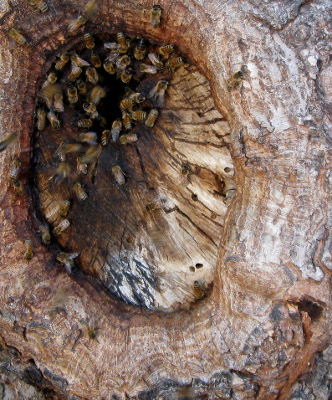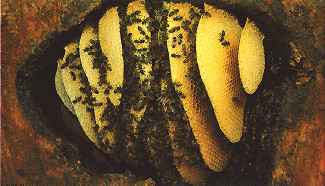
Wild honeybee hives
 Before
I write about modern beekeeping methods that promote healthier bee
populations, let's take a step back and look at the way honeybees live
in the wild. Although some of them will move into the walls of
our houses (oops), most feral honeybees prefer to nest in hollow
trees. That means they are quite well insulated from the
elements, with thick wooden walls on the sides and an even thicker
"roof" above their heads.
Before
I write about modern beekeeping methods that promote healthier bee
populations, let's take a step back and look at the way honeybees live
in the wild. Although some of them will move into the walls of
our houses (oops), most feral honeybees prefer to nest in hollow
trees. That means they are quite well insulated from the
elements, with thick wooden walls on the sides and an even thicker
"roof" above their heads.
Nest chambers of
wild bees are vertically elongated cylinders with a
capacity of about 8 to 16 gallons. To give you a frame of
reference, the deep brood box that most Langstroth hives begin with has
a capacity of about 11 gallons, and beekeepers generally add on at
least one more deep brood box or two shallow supers. That makes
the wild bee hives sound small, but keep in mind that wild bees don't
sock away as much honey as we ask our bees to. Instead, they
swarm as soon as conditions in the hive start to get cramped, sending
out a daughter colony to make a new hollow her own.
 Wild bee hives are usually at
or near the base of a tree and the
entrances are generally at the bottom of the hollow. Entrances
vary in size depending on the capacity of the tree, but range from
about 4 to 16 inches in diameter.
Wild bee hives are usually at
or near the base of a tree and the
entrances are generally at the bottom of the hollow. Entrances
vary in size depending on the capacity of the tree, but range from
about 4 to 16 inches in diameter.
The bees chew away rough
bark at the entrance to make a smooth landing
area, then they coat the inside walls with propolis. Combs are
fastened to the top and sides of the chamber, but the bees leave small
passageways along the edges to allow them to move around inside
easily. They put honey in the top of the combs, then pollen, and
care for their brood below.
Can we develop a hive
that allows for human management while keeping as
many of these wild bee characteristics as possible? Tomorrow's
post will suggest one possible compromise.
| This post is part of our The Barefoot Beekeeper lunchtime series.
Read all of the entries: |
Want more in-depth information? Browse through our books.
Or explore more posts by date or by subject.
About us: Anna Hess and Mark Hamilton spent over a decade living self-sufficiently in the mountains of Virginia before moving north to start over from scratch in the foothills of Ohio. They've experimented with permaculture, no-till gardening, trailersteading, home-based microbusinesses and much more, writing about their adventures in both blogs and books.
Want to be notified when new comments are posted on this page? Click on the RSS button after you add a comment to subscribe to the comment feed, or simply check the box beside "email replies to me" while writing your comment.
